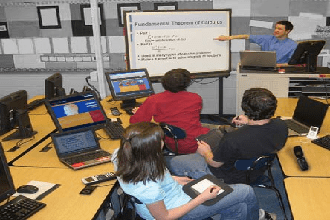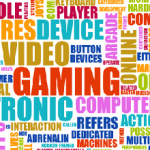Imagine two scenarios, first teacher enters into the class, pushes a remote button, the blackboard screen turns to life, one half shows a digital display of a Prezi presentation, other half shows a live synchronisation with another professor from a different
reputed university. The class starts, and the obvious “always in doubt person” asks a doubt. Teacher pushes another button, the digital display changes into an informative video, with a link for further reference. Finally the class ends, teacher e-mails you all the links and puts the e-books on the Dropbox for you to download. Moreover you are given a task to tweet about it and also to make a page on Facebook.
Scene two, teacher enters into a sleeping class, slams down 3 heavy books on the desk. Turns towards the blackboard, and starts speaking some very meaningful sentences. The “doubt kid” asks a doubt, which the teacher explains after turning 20-30 pages of one of the book and he/she sits down because of the fear of getting a “D”.
So, which one is better, more interactive, lucrative?
The answer is very evident. The generation today loves technology and expects the same from his/her ideal person. Teachers generally play that role, and if they don’t use technology, an invisible wall gets erected in between them.
Technology doesn’t teach, Teachers teach. But today, Teachers who don’t use technology will be replaced by teachers who do.
Teachers today themselves use technology in their day-to-day lives. They blog, connect through social media , own laptops, iPhone, iPad etc. So, will it not be better if a teacher instead of just sitting on the chair and checking his/her Facebook wall, could rather comment and interact on some post by a student of the class. The student immediately starts a discussion with his own device and thus the knowledge gets shared.
The use of technology has helped the special need disciples the most. They can see videos, play digital learning games and gain knowledge in the process.
It is believed that elementary school teachers always have a headache. The controlling of class seems to take a toll. Enters technology, now students are self-engaged, digital learning games , videos, software for imaging, story animations etc. Result, teachers can finally take their hands off their heads!!!
Learning means to make people smarter, independent, thinker and analyst. Technology caters to all of these, so why not to make the process of making people smart, smarter?
It has not remained a question, if the teachers should use technology or not, rather the question has been transformed to find different innovative techniques to make learning more easy, smart and fast through technology.
Earlier teachers could teach only inside the boundary of school walls, outside students were least interested. The scenario has changed completely, students now devote equal time to learning in their homes as well.
A real life example of smart learning- Professor Tomarken, who teaches advanced statistics and methods classes( Vanderbilt faculty member), faced a serious problem of the lack of a good textbook for teaching structural equation modeling to social science students – that he solved using technology. “There is no book that is perfect, that really is appropriate, for this class. There are either books that tend to be too easy or too hard or just not broad enough in scope.” Tomarken solved this problem using the Prometheus system, by placing his lecture notes on the web. This not only replaced the textbook, it allowed students to spend more time focused on the lecture and less time copying formulae from the board.
There are three key factors for a technology to accomplish widespread use and to be accepted by teachers: pedagogical flexibility, support for teacher control, and accessibility (Cuban, 1986, 2001; Kent & McNergney, 1999). The current mixture of technology provides credible evidence of the importance of these three factors.
These “innovations” can be flexibly integrated into teachers’ curriculum plans and provide options for teachers to shape or shift their instruction whenever they think appropriate.
Teachers also can utilize these without reducing their control over the classrooms. Their flexibility and low cost make them accessible and pervasive for teachers and students alike.
So, if today a teacher doesn’t want to be called “old-fashioned” or “boring” then he/she needs to shift to smarter teaching, i.e. technological teaching.


